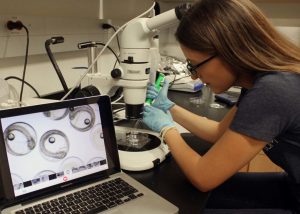Study Finds Oil, UV Radiation, and Temperature Affect Mahi Survival Processes
– MAY 17, 2018
Researchers conducted exposure experiments with mahi-mahi embryos using oil, ultraviolet (UV) radiation, and temperature to determine how multiple stressors affect their survival. Compared to controls, exposed embryos floating near the ocean’s surface started to sink sooner and at faster rates, which intensified at higher temperatures. The embryos also exhibited higher oxygen consumption rates that correlated with increased yolk sac depletion, which may be due to its quickly providing nutrients and energy to embryos in response to their increased oxygen consumption. Results from UV radiation treatments suggest a possible behavioral response whereby embryos might recover buoyancy by sinking when UV radiation increases and returning to the surface when it diminishes. The researchers published their findings in Aquatic Toxicology: Combined effects of oil exposure, temperature and ultraviolet radiation on buoyancy and oxygen consumption of embryonic mahi-mahi, Coryphaena hippurus.
The Deepwater Horizon incident overlapped with the spawning of economically and ecologically important fish species, potentially exposing them to tricyclic hydrocarbon compounds, known to impair developing embryos’ hearts. Mahi-mahi embryos float in the upper layers of the water column then hatch into larvae which remain near the ocean’s surface as they develop. As such, both the embryos and larvae of this pelagic fish could have experienced multiple stressors at the same time – oil, UV radiation, and high temperatures. Researchers of this study extended a NRDA investigation of oil and sunlight impacts on mahi-mahi embryos to learn about affects from these three simultaneous stressors.
The team diluted 100% unfiltered water-accommodated fraction (from oil collected during Deepwater Horizon skimming operations) to 4% using UV-sterilized seawater, in line with levels reported previously (Diercks et al., 2010; Bejarano et al., 2013; Wade et al., 2011). After various exposure treatments, they measured buoyancy, oxygen consumption, sinking rates, hatch times, and yolk sac depletion – critical survival components.
Temperatures at 30 °C yielded higher oxygen consumption rates in all embryos compared to 26 °C treatments and induced negative buoyancy at earlier time points. Time to 50% hatch was faster at 30 °C than 26 °C but did not differ between treatments at either temperature, indicating that early onset of negative buoyancy and increased oxygen consumption rates were not a result of faster development and earlier hatch time in mahi-mahi embryos exposed to various environmental stressors. All embryos raised at 30 °C exhibited significant yolk sac depletion. Embryos in control, oil-only, and UV-oil treatments exhibited rapid increases in sinking rates, and embryos in UV-only treatments had faster sinking rates post-exposure and pre-hatch.
Author Christina Pasparakis discussed their results, “Our findings highlight the need to assess the impact(s) of oil exposure in the context of interacting ecological stressors to gain a more comprehensive understanding of the downstream impacts of oil spills in general, and the 2010 Gulf of Mexico spill in particular. The prevailing view is that embryos of pelagic fish float in the surface and become negatively buoyant just prior to hatch. However, we found evidence that exposure to multiple stressors affect negative buoyancy onset in early life staged mahi-mahi.”
Pasparakis said that the combination of this earlier negative buoyancy and faster sinking rates might cause embryos to leave suitable habitat. “This is especially worrisome considering that these embryos are already at a disadvantage due to reduced energy reserves located in the yolk sac, which is the sole provider of nutrition in developing fish until larvae are able to forage for food exogenously.”
The team’s observations of treatments with UV radiation imply that embryos can sense light and dynamically control buoyancy. “The demonstrated avoidance of UV by embryos of pelagic fish may mean that these embryos are not floating under natural conditions as presently assumed.”
Data are publicly available through the Gulf of Mexico Research Initiative Information & Data Cooperative (GRIIDC) at doi:10.7266/N7GH9G95.
The study’s authors are Christina Pasparakis, Lauren E. Sweet, John D. Stieglitz, Daniel Benetti, Conrad T. Casente, Aaron P. Roberts, and Martin Grosell.
************
This research was made possible in part by a grant from the Gulf of Mexico Research Initiative (GoMRI) to the Relationship of Effects of Cardiac Outcomes in Fish for Validation of Ecological Risk (RECOVER) consortium.
The Gulf of Mexico Research Initiative (GoMRI) is a 10-year independent research program established to study the effect, and the potential associated impact, of hydrocarbon releases on the environment and public health, as well as to develop improved spill mitigation, oil detection, characterization and remediation technologies. An independent and academic 20-member Research Board makes the funding and research direction decisions to ensure the intellectual quality, effectiveness and academic independence of the GoMRI research. All research data, findings and publications will be made publicly available. The program was established through a $500 million financial commitment from BP. For more information, visit https://gulfresearchinitiative.org/.
© Copyright 2010-2018 Gulf of Mexico Research Initiative (GoMRI) – All Rights Reserved. Redistribution is encouraged with acknowledgement to the Gulf of Mexico Research Initiative (GoMRI). Please credit images and/or videos as done in each article. Questions? Contact web-content editor Nilde “Maggie” Dannreuther, Northern Gulf Institute, Mississippi State University (maggied@ngi.msstate.edu).






